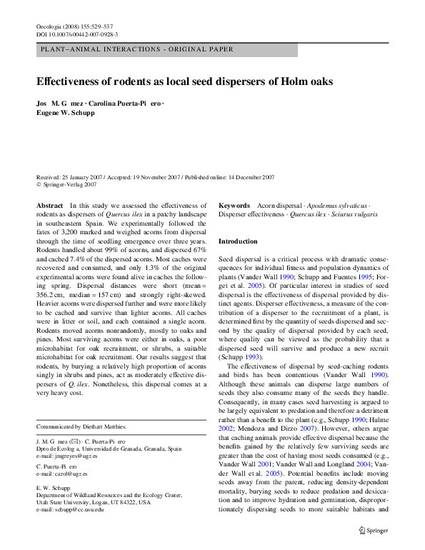
Article
Effectiveness of Rodents as Local Seed Dispersers of Holm Oak
Oecologia
(2008)
Abstract
In this study we assessed the effectiveness of rodents as dispersers of Quercus ilex in a patchy landscape in southeastern Spain. We experimentally followed the fates of 3,200 marked and weighed acorns from dispersal through the time of seedling emergence over three years. Rodents handled about 99% of acorns, and dispersed 67% and cached 7.4% of the dispersed acorns. Most caches were recovered and consumed, and only 1.3% of the original experimental acorns were found alive in caches the following spring. Dispersal distances were short (mean= 356.2 cm, median = 157 cm) and strongly right-skewed. Heavier acorns were dispersed further and were more likely to be cached and survive than lighter acorns. All caches were in litter or soil, and each contained a single acorn. Rodents moved acorns nonrandomly, mostly to oaks and pines. Most surviving acorns were either in oaks, a poor microhabitat for oak recruitment, or shrubs, a suitable microhabitat for oak recruitment. Our results suggest that rodents, by burying a relatively high proportion of acorns singly in shrubs and pines, act as moderately effective dispersers of Q. ilex. Nonetheless, this dispersal comes at a very heavy cost.
Keywords
- Effectiveness,
- Rodents,
- Local,
- Seed,
- Dispersers,
- Holm Oak
Disciplines
Publication Date
March, 2008
DOI
DOI 10.1007/s00442-007-0928-3
Citation Information
Gómez, J.M., C. Puerta-‐Piñero, and E.W. Schupp. 2008. Effectiveness of rodents as local seed dispersers of Holm oak. Oecologia 155: 529-537.
